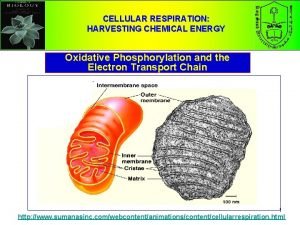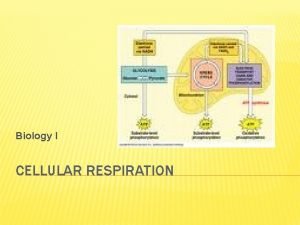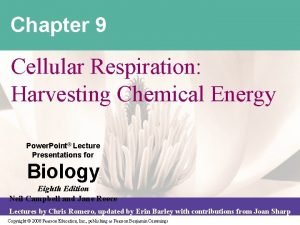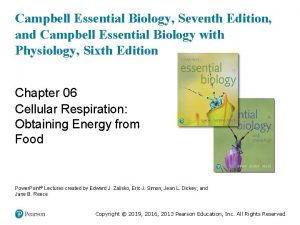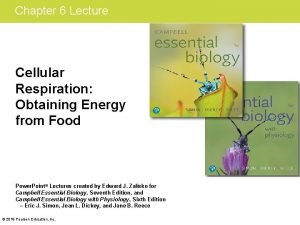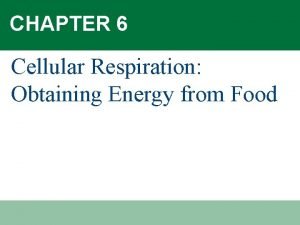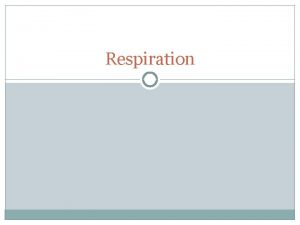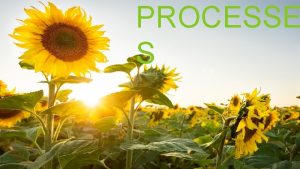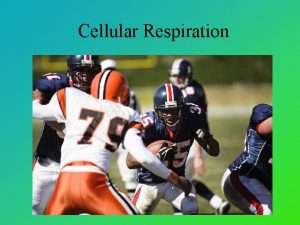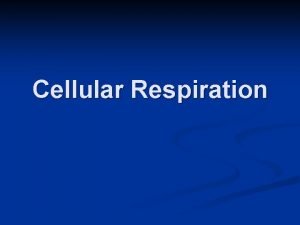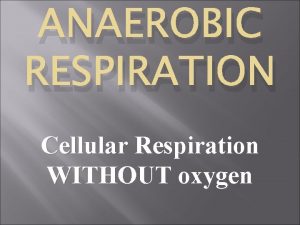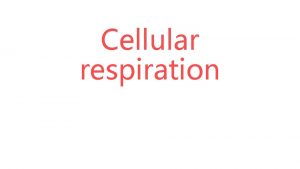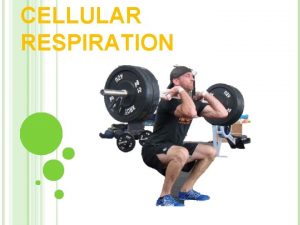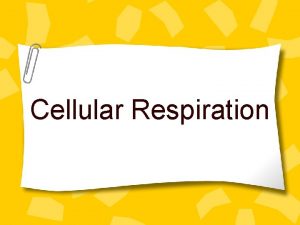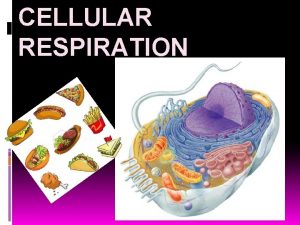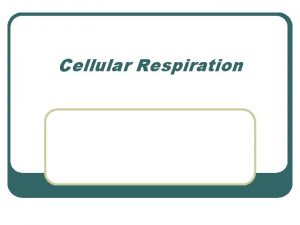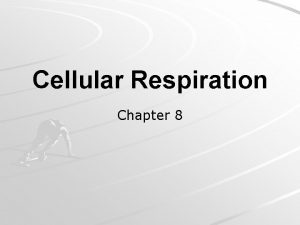Cellular Respiration Chemical Energy Cellular Respiration is how




















- Slides: 20

Cellular Respiration

Chemical Energy Cellular Respiration is how your cell turns the food you eat into energy for your cells. p Calorie: the amount of energy needed to raise the temperature of water 1°C p

Cellular Respiration p Overview: n The mitochondria in cells breaks down glucose and produces energy in the form of ATP.

Cellular Respiration 6 O 2 + C 6 H 12 O 6 6 CO 2 + 6 H 2 O + ENERGY * The equation for cellular respiration is just photosynthesis backwards!

Energy Production p There are 2 ways for a cell to make energy depending on the presence of oxygen… 1) Fermentation (anaerobic) 2) Cellular Respiration (aerobic)

Energy Production Prefix review: A- : means without Aero- : means air or oxygen Therefore…. p Aerobic means with oxygen Anaerobic means without oxygen

Energy Production BOTH ways a cell makes energy starts with Glycolysis p Glycolysis: The process in which glucose is split n Happens in the cytoplasm n Happens in all living organisms

Energy Production

Cellular Respiration p Three stages of cellular respiration 1. Glycolysis - anaerobic 2. The Krebs Cycle (aka: Citric Acid Cycle) - aerobic 3. The electron transport chain – aerobic * The aerobic stages create the most ATP

3 Stages of Cellular Respiration Step 1: Glycolysis p Starts with glucose p Produces ATP, electron carrier, & pyruvate p Occurs in cytoplasm

3 Stages of Cellular Respiration Step 2: Krebs cycle ( AKA citric acid cycle) p Starts with pyruvate (converted to acetyl-Co. A) p Produces CO 2 , ATP, & electron carriers p Occurs in matrix of the mitochondria

The Krebs Cycle (Citric Acid Cycle)

Cellular Respiration p STEP 3: Electron Transport Chain n Uses high energy electrons (from Krebs) and Oxygen n Produces ATP and water n Occurs in the inner mitochondrial membrane

The Electron Transport Chain

Cellular Respiration p The Whole Package… Produces 38 ATP!

Fermentation p Happens when there is NO oxygen present p Anaerobic means without oxygen p Produces less energy than aerobic respiration

Alcoholic Fermentation Occurs in cytoplasm of bacteria & yeast p Starts with pyruvate (from glycolysis) p Produces ethyl alcohol & carbon dioxide p Uses: makes alcohol & bread p

Lactic Acid Fermentation Occurs in cytoplasm of muscle cells & bacteria p Starts with pyruvate (from glycolysis) p Produces lactic acid p Causes. . . burning sensation after vigorous exercise p Uses: makes sauerkraut & yogurt p

Energy Use p Quick Energy: ex. Sprints. n Energy obtained through lactic acid fermentation n Why you feel a burning sensation p Long-Term Energy: energy made by cellular respiration

The Big Picture Aerobic Cell Respiration -Uses Oxygen -Produces 38 ATP Anaerobic Fermentation -No Oxygen -Produces only 2 ATP
 Cellular respiration harvesting chemical energy
Cellular respiration harvesting chemical energy Chapter 9 cellular respiration harvesting chemical energy
Chapter 9 cellular respiration harvesting chemical energy Chapter 9: cellular respiration: harvesting chemical energy
Chapter 9: cellular respiration: harvesting chemical energy Cellular respiration harvesting chemical energy
Cellular respiration harvesting chemical energy What's the equation for cellular respiration
What's the equation for cellular respiration Chemical equation for cellular respiration
Chemical equation for cellular respiration What is the chemical formula of cellular respiration
What is the chemical formula of cellular respiration Inputs of glycolysis
Inputs of glycolysis Chemical cycling in an ecosystem
Chemical cycling in an ecosystem Cellular respiration obtaining energy from food
Cellular respiration obtaining energy from food Cellular respiration obtaining energy from food
Cellular respiration obtaining energy from food Chapter 8 section 1: how organisms obtain energy
Chapter 8 section 1: how organisms obtain energy Cellular respiration redox
Cellular respiration redox The gray-brown haze often found over large cities is called
The gray-brown haze often found over large cities is called Cellular respiration steps
Cellular respiration steps Aerobic vs anaerobic
Aerobic vs anaerobic Fermentation
Fermentation Why is cellular respiration important
Why is cellular respiration important Complimentary processes
Complimentary processes Cellular respiration reactants
Cellular respiration reactants Cellular respiration and photosynthesis equation
Cellular respiration and photosynthesis equation



